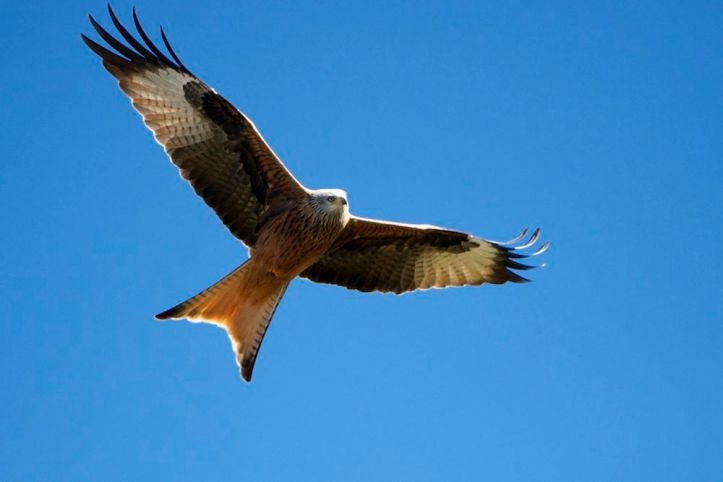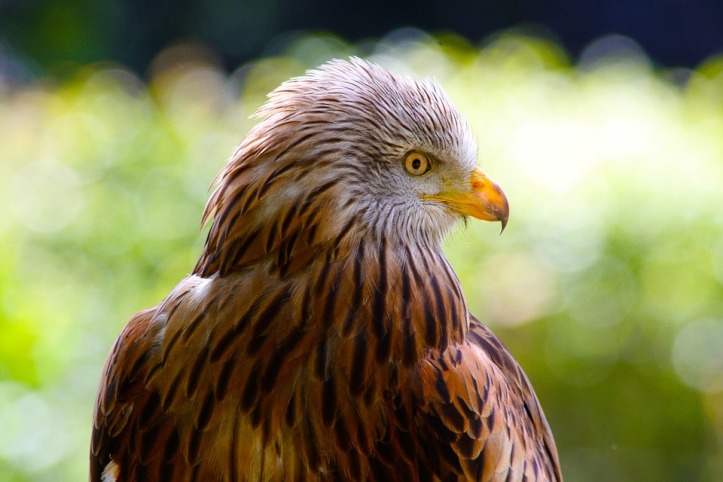
Sailing in from the distant sky, a blue-grey sea of spring calm and placid cloud, I thought at first another Common Buzzard was making routine rounds above the open fields in search of Rabbits. As the distant blotch of wing and body circled nearer, I noticed in the flight a grace that Buzzards, with their stocky build and scruffy plumage lack entirely. From beneath, chess-board wing tips of milk and charcoal washed like watercolour into russet-brown and copper slender wings. Wings without beats gave way to a flecked and muted orange body and then the tail; the tell-tale sign of a soaring kite, the giveaway, forked and angular like the fletching of an ancient arrow. Red Kite.
I came to this spot, some two miles south-east of the edgeland, in search of boxing Hares this morning, as I do each year. These wide and open arable fields are a little known Hare hot-spot and on a good day, especially at dusk and dawn, the fields around Wistow come alive with the bounding hinges of hind legs and black-tipped, impossibly long ears that reach out like periscopes above the grass and stubble. Not today though, the fields still too barren, the grass to short to conceal forms and hunckering spots. The Red Kite is ample consolation.
It is only in the last couple of years that Kites have eclipsed my binocular lens in South Leicestershire, five or six years perhaps since sightings first emerged. This is the closest I’ve found to the edgeland but Kites will range widely and it is not unlikely that this bird has risen on the thermals in edgeland airspace. This revival is the visible harvest of seeds sown by a reintroduction programme over a decade ago in neighbouring Northamptonshire, part of a wider programme covering much of the British Isles. It seems hard to imagine now the Red Kite as previously one of Britain’s most common raptors; so common in fact that alongside the Raven, the Red Kite served the growing city of London as invaluable street cleaner during the middle-ages. Emptying the festering city streets of food waste, lost livestock and even human remains, thanks to the great Plague. So valuable was the Kite that it was even protected by royal decree; killing a kite attracted capital punishment. Things changed dramatically in the sixteenth century when suddenly Kites found a bounty on their heads and birds were killed in the hundreds having been labelled nothing short of vermin.
The Persecution continued long into the 1800’s at the hands of gamekeepers; wrongly blaming Kites for killing game birds (Red Kites will occasionally kill for food, much like Buzzards, but mainly scavenge on carrion). Before long, Red Kites were so scarce that taxidermists and egg collectors hammered the final nails in the coffin and by 1871 Red Kites were extinct in England. Scotland followed suit just eight years later. By the time Red Kites became a protected species by law in 1903 only a handful of pairs remained, resigned to remote mid-Wales. Numbers barely shifted, increasing to just twenty pairs in Wales by 1960, all of which (as proven by DNA sampling) had derived from a single female bird. The recovery was slow and hampered throughout the 1950’s by rabbit myxomatosis, the Kites main source of food. Since the late 60’s numbers have increased steadily, the Red Kite once again has a range, at least in pockets, extending almost across the length and breadth of the United Kingdom. Sadly, ignorance still exists and In Scotland (especially the North) levels of Red Kite persecution have not fallen in the last 25 years, at the estimated cost of an extra 1000+ breeding pairs, despite the reintroduction programme.

Happy am I then, to be gazing skywards at this sublime chalk face, daffodil bill and piercing golden eye. For all their troubled history, the Red Kite remains, in my opinion, one of the most magnificent looking birds on these isles. Still a wing yet to beat, the Kite soars ever higher and more distant until beyond the reach of my gaze.
Amongst this arable land, other conservation measure are noticeable too. I’ve noted over the years that the farmer here leaves corn stubble around all of the field boundaries in winter and evidence of their benefit is in abundance. The first two birds I come across are typical farmland birds; birds that have been in decline, drastic decline, for a number of years thanks to the rapid growth in intensive farming. Atop a bramble hedge beside the stubble perches a resplendent male Reed Bunting. Jet-black cap and Sparrow-back. Dashing in and out of the stubble, the Budgerigar, almost alien brightness of Yellowhammers. I watch on as three of them come to rest in the hedge. In stark contrast to the increasingly greying sky and the naked, bare brown of the leafless bramble the birds, especially one male in full breeding plumage, radiate like warm Sicilian lemons from a grove. I feel their warmth rise up like sap through my veins whenever I happen upon them; one of my favourite birds, and one of those in the most trouble. To find Yellowhammers thriving is to know that the land is being managed well.
 As my walk meanders along the boundary of a large copse, marked on the Ordinance Survey maps as ‘fox covert’, I notice at the woodlands edge, amongst the yellow lichen covered Hawthorn, a huge number of petite nests perched precariously right on the open edge. It amazes me to see these humble abodes within touching distance of man knowing that in a couple of months, hidden only by new-leaf and bud, hundreds of Wrens and Goldcrests will be busy feeding vulnerable young mouths. I inspect some of last seasons nests as I walk. To tell a Wrens nest is obvious; the bowl small and rotund, lined neatly with moss. To tell a Goldcrest nest is even more obvious; the work much the same as the Wrens but the concave hollow amongst the moss and fine twigs no larger than a satsuma, impossibly small even for a Wren. To envisage a clutch of 10-12, impossibly tiny eggs is one thing. To imagine a brood of ten little chicks, huddled together in a cup not large as half a tennis ball seems ridiculous.
As my walk meanders along the boundary of a large copse, marked on the Ordinance Survey maps as ‘fox covert’, I notice at the woodlands edge, amongst the yellow lichen covered Hawthorn, a huge number of petite nests perched precariously right on the open edge. It amazes me to see these humble abodes within touching distance of man knowing that in a couple of months, hidden only by new-leaf and bud, hundreds of Wrens and Goldcrests will be busy feeding vulnerable young mouths. I inspect some of last seasons nests as I walk. To tell a Wrens nest is obvious; the bowl small and rotund, lined neatly with moss. To tell a Goldcrest nest is even more obvious; the work much the same as the Wrens but the concave hollow amongst the moss and fine twigs no larger than a satsuma, impossibly small even for a Wren. To envisage a clutch of 10-12, impossibly tiny eggs is one thing. To imagine a brood of ten little chicks, huddled together in a cup not large as half a tennis ball seems ridiculous.
As I crouch beneath the Hawthorn shell of the wood and hop over a Rabbit warren to find myself beneath the canopy – an eclectic mix of naked deciduous trees and cone-covered pines that extends some forty metres across and one hundred metres in length – my wife spots a fresh sign of Spring. On the woodland floor black-blotched, waxy jungle-green, lush foliage is starting to rise skywards, soaking in the light whilst the empty canopy affords. It is Lords and Ladies; a wildflower more recognisable in late summer for its spikes of Red, Orange and Green fruit, clusters of bell peppers in miniature. All around the bare earth is turning slowly a shade of green with seedlings and shoots seemingly waking by the minute. Deadwood and natural log piles are breeding new life; sphagnum moss thriving on the damp rot glows almost luminous. Above, Coal Tits and Great Tits attack pine cones, the seeds probably long since consumed but the crevices they leave behind harbouring insect life, itself slowly waking from Winter slumber.
Leaving the woods behind and heading back, bird song carried on the mild breeze is in full throng. In late Winter it creeps back into our consciousness slowly, having deserted us almost entirely for months, until in early Spring it is upon us, sudden as an orchestra. Crows mob a Buzzard above insistently, Keeeee Keeeeee cries of annoyance add another layer to the music and as we reach the car there is a final note. I have been watching Woodpeckers in the edgeland throughout Winter but I haven’t heard this particular note, this drum-roll, since last summer. The reverberating tap-tap-tap of a bill hammering against hollow, decaying wood provides perfect percussion to the melody. With that single sound the song of Spring and Summer has officially begun; the band will continue to play for many months to come. That is music to my ears.

Beautifully described and evocative. Do you know if the farmers who leave stubble are part of an environmental stewardship scheme?
LikeLiked by 2 people
Thank you Philip, very kind. I was under the assumption that the farmer in question probably is working under the environmental stewardship scheme but I’m not certain. Might be worth me finding out!
LikeLiked by 2 people
Beautiful, I really enjoyed reading this, thanks for sharing.
LikeLiked by 2 people
Thank you so much!
LikeLike
Wonderfully written!
LikeLiked by 1 person
Kind words, thank you, it means a lot!
LikeLiked by 1 person